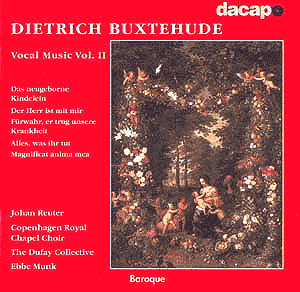DIETRICH BUXTEHUDE
(1637-1707)
Vocal Music Vol. II
Das neugeborne Kindelein [7.14]
Der Herr ist mit mir [8.10]
Alles, was ihr tut [12.33]
Förwarh, er trug unsere Krankheit [14.20]
Appendix
Magnificat anima mea [8.40]
 Johan Reuter, bass Johan Reuter, bass
Copenhagen Royal Chapel Choir
The Dufay Collective, Ebbe Munk
Rec: June 2000
 DA CAPO 8.224160 [50.59] DA CAPO 8.224160 [50.59] |
 |
|
Dietrich Buxtehude was a Danish composer who was later naturalized German.
He spent most of his life in Lübeck, where he worked as organist at
St. Mary's church. Well-known and respected during his lifetime, he was what
might be called, today, a composer's composer. At the age of 20, Johann Sebastian
Bach, in his strong desire to meet the master and learn from him, walked
250 miles to visit Buxtehude.
Buxtehude wrote a wide variety of music - from beautiful works for harpsichord,
to masterpieces for organ, by way of vocal music, such as that on this recording.
He also started a series of concerts separate from church services called
Abendmusik (Evening music), to provide musical entertainment for the town's
bourgeoisie.
The first work on this recording, Das neugeborne Kindelein (The Newborn Babe)
begins with strings and continuo, the violins playing a catchy melody with
a distinctly French sound - one recognizes, as in many of Buxtehude's works,
the strong influence of French baroque music. The chorus then joins, with
a texture that is different than the usual German chorus of this period.
Buxtehude shows, here, that he was a master of melody, and was able to arrange
these melodies in limited ensembles to great effect. He directed these works
from the organ, which is why the continuo uses an organ rather than a
harpsichord, and the organ provides an anchor for the full range of sound
he deploys.
Der Herr ist mit mir is a more introspective work. Starting in a similar
fashion as the first piece on this recording, the choral sections alternate
between a more sombre sound and a joyous sound, as its sings Halleluiah.
The chorus here is more present than in the first work, with its range covering
a much greater scope.
Förwarh, er trug unsere Krankheit is a work of larger scale than the
first two. It is scored for bass, chorus, 2 violins, 2 viola da gamba, violone
and basso continuo. Beginning slower, and more mass-like, the instrumental
section lays out a fabric of melody almost like a short overture, before
the bass starts singing a slow, introspective melody. He sings a short aria,
then several soloists from the choir sing a short psalm-like work accompanied
only by organ. The bass returns, and this alternation continues throughout
the piece. The strings are constantly in the background, maintaining cohesion
between the different parts. The gambas give this work about grief a very
earthy sound, especially toward the end of the piece, when the strings play
a very moving passage alone. Unfortunately, bass Johan Reuter sounds as if
he is standing somewhere in the back of the church. The sound here is strange
- the organ is very present, which makes sense, considering the context of
the performance of these works, and the strings as well. The chorus has a
rich sound, and the soloists from the chorus sound clear and clean, but the
bass is lost in the distance.
There is a certain starkness in the orchestration of these works - which
are played, in addition to the singers, by only strings and organ. Compared
to Bach's cantatas, for example, which often feature winds, horns or other
instruments, these works are much more austere. Yet, this austerity is perfectly
counterbalanced by the incredible joy vehicled by the music. These works
are full of hope and gladness. In most of them, violins are constantly weaving
their melodies together with and behind the vocal parts, reminding the listener
of the liberating power of this music.
Alles, was ihr tut is a more restrained work than the previous one. While
it has the same scoring, it does not feature soloists from the choir, but
does include a harpsichord in the continuo. Opening again with a French-style
beginning, this work is more like a cantata - it contains a chorus, aria,
arioso, choral and final chorus. Melodically, this is perhaps the most beautiful
work on the recording. The unique rhythm of the chorus in counterpoint with
the strings in the opening chorus is almost foot-tapping music. The gambas
again provide a melancholy, yet upbeat sound, in the opening to the aria,
which is sung by the choir. This aria sounds very much like a hymn. Its several
verses provide a solid base for the listeners, who are exhorted to praise
God and work for Him. Next comes a brief arioso for bass singing alone over
the organ - this time sounding better than in the previous work. A choral
and closing chorus follow, melodically similar to the rest of the piece.
Unlike many cantatas, the different movements here are all developed around
the same melodies.
The final work, listed as an "appendix" is not certain to be by Buxtehude.
It does not have the same melodic beauty as the other works, but is nevertheless
an attractive piece, again for choir, strings and continuo.
This is a beautiful recording of some of Buxtehude's most interesting vocal
works. This composer deserves to be much better known; these works are remarkable
in their emotion and feeling.
Kirk McElhearn

